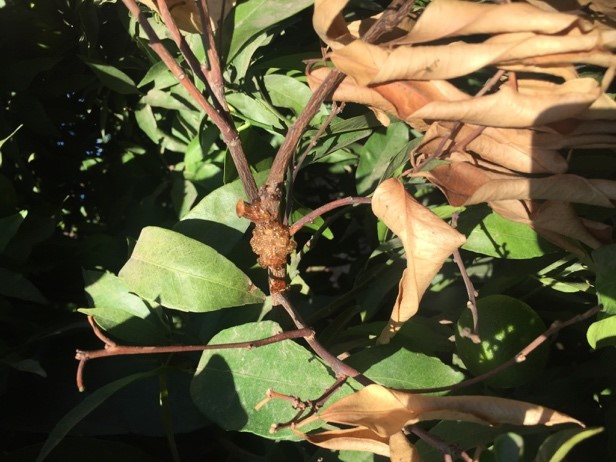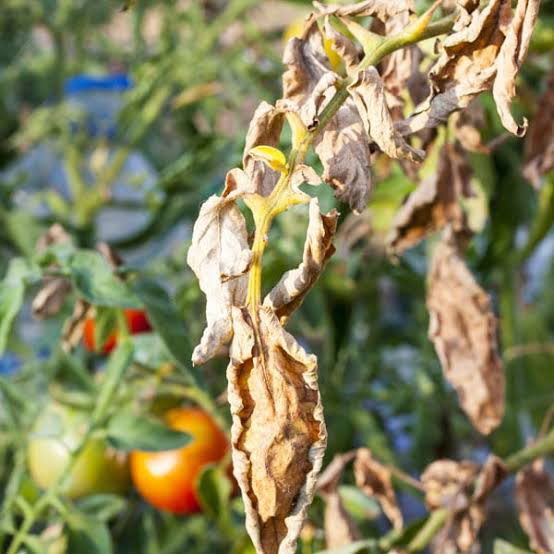Disease Symptom Definition
Well defined, self limiting lesion on aerial plant parts are called spot. They are often named after the plant part on which they are present, for instance on the leaves are called Leaf spot. These maybe of various shapes such as round , circular ,angular, etc. and are often light to dark brown or black in colour. It is worthy to note that in angular leaf spots, veins and vein lets normally restrict the spread of infection.
Blotch
Large areas of discoloration on leaves, fruits etc. are called blotches. There spread on the leaves is not restricted by veins.
Anthracnose
Black or charcoal like, slightly sunken lesion on leaves, stems or fruits result in a disease.
Canker
A necrotic, often sunken lesion, on a stem, branch or twigs of plants is called a canker.
Scab
A rough, crust like lesion on a plant part, showing surface layer thickening ; or the disease condition in which such areas form is termed scab.
Rot
Softening, discoloration and decay of succulent plant tissue as a result of infection is called rotting. Root rot, foot rot, crown rot, bulb rot, collar rot, soft rot, rhizome rot, sett rot, stem rot etc. are some common types of rots.
Damping off
Death and collapse of seedling at or near the soil line is normally referred to as damping off. However, in the strict sense of the term, decay of seeds in the soil or of seedlings before or after their emergence from the soil is called damping off. It is very common in the nursery and they often result in heavy seedlings mortality. If the seedlings are vary mildly infected they may withstand attack but carry infection to the field and at a later stage succumb if weather turns favourable.
Gummosis
External or internal production of an exudates or gum by the plants tissue is referred to as gummosis.
Dieback
Death, decay or drying of twigs or branches from tip downwards is called dieback. Discolouration or darkening of the bark is a very common features in such diseases.
Wilt
A diseased condition that result in dropping of plant parts generally caused by insufficient transport of water in the plants is called wilting. It may occurs due to pathological or a physiological cause.
Shot hole
A disease symptoms in which leaf lesion becomes cicatrized and fall away drop off and leave small holes in their place, is called shot hole.
Mould
A disease in which the mycelium or spores of the fungus are seen as a blackish, brownish, bluish or grayish growth on the host surface. The term also refers to fungal growth, which may be present on the non living substrate, too. Sooty mould is common disease affecting plants and is caused by saprophytic fungi . It is appears as a sooty or black coating on plants and is commonly associated with honeydew secreted by insect such as aphids, mealy bugs, scales and white flies.
Mildews
A disease in which mycelium and spores of the fungus are seen as a whitish or grayish growth on the host surface agripdfs is called mildew. The leaves are most commonly infected, whereas the other arial plant parts are not exception. If growth develops mainly on the lower surface of the leaves named downy mildew. On the contrary, growth develop on upper surface named powdery mildew.
Rust
A disease representing a “rusty “look to a plants is called rust. It is caused by fungi belonging to the order Uredinales.agripdfs
A disease characterized by masses of dark, powdery and sometimes odorous spores and caused by one of the members of fungi belonging to the order ustilaginales.
A swelling or overgrowth produced on plant due to infection by certain pathogen to called a gall. The galls are commonly noticed on leaves and roots.
Tumor
An uncontrolled overgrowth of tissue due to infection by a pathogen is called tumor.
Mosaic
Presence of dark and light – green or yellow areas on leaves of virus – affected plants, is known by the name mosaic. Associated with them may be thickening, puckering or distortion as well as ring, line and streak patterns may also be encountered in mosaic – types f disease. Vein clearing or vein – banding is also a common symptoms of infection with mosaic diseases.
Colour - break
Narrow elongated streaks r stripes of indefinite or restricted length on flower petals often result in variegation in flower colour and the symptoms are known as colour – break.
Witches broom pigeon pea
Broom- like growth or massed proliferation is caused by dens clustering of branches of woody plants. In such diseases the agripdfs internodes gate shortened and the numbers of stems is greatly increased.
Chlorosis
Yellowing of normal green tissue due to destruction or failure of chlorophyll to form is called chlorosis. It is called general chlorosis when uniformly present white interveinal when present between the veins.
Necrosis
Death and discoloration of tissue is called necrosis.
Scorching
Appears as burning of margin or nearly whole leaves as a result of infection or unfavourable environmental conditions.
Stunting or dwarfing
It is reduction in the size of plant. It generally result from fungal, bacterial viral or nematode infections.
✨Symptoms and nutrient deficiency✨
🌿 Tea yellows -Sulphur
🍅 Blossom end rot of tomato and pepper - Calcium
🥕 Cavity spots in carrot - Calcium
🍠 Black head in celery - Calcium
🥬 Internal browing in brussels sprouts - Calcium
☘ Sand drown in tobacco- Magnesium
🌞 General starvation - Nitrogen
🍠 Cracked stem of celery- Boron
🥦 Browing of cauliflower-Boron
🍀 Lucerne yellow or yellow top- Boron
🍎 Internal cork of apple- Boron
🌲 Ivy leaf of hop - Boron
🍑 Brown spotting of apricots- Boron
🍓 Die back of raspberries-Boron
🌾 Stem melanosis of wheat-Copper
🍎 Die back of apple trees-Copper
🌱 Reclamation disease of cereals- Copper
🥜 Little leaf or sickel shape of groundnut- Zinc
🥥 Rosette or little leaf of coconut-Zinc
🍊Mottle leaf or frenching in citrus crop- Zinc
🥔 Fern leaf of potato - Zinc
🌾 Khaira disease of paddy - Zinc
🌳 Strap leaf of hibiscus-Molybdenum
🥬 🥦 Whip tail of cauliflower- Molybdenum
🎋 Freckling of sugarcane - Silicon





















Comments
Post a Comment